Rust, Germany – Tuesday, March 30th, 2010
Although I had a fulfilling time during my first day at Europa Park, some of my goals for day two included: ride the last two coasters I haven’t yet been on, explore the eastern edge of the park, get as many rerides on Blue Fire as possible, same goes for Silver Star and Eurosat, get at least one to two more rides on all the other coasters, and sample the rest of their selection of dark rides, water rides and flat rides, all in about an eight hour period. With the crowds even lighter than the day before but most of the rides operating at their maximum or near-maximum capacity, Europa Park was effectively transformed into my personal playground as soon as I handed in the remaining stub from my 2-day ticket at the entrance gate.
First off I hurried off to grab some Blue Fire rides before the potential crowds made their way back to that area of the park. Scored four laps right off the bat, nice. Afterward I went over to the Portugal section to try one of two coasters I had yet to experience the previous day, Atlantica SuperSplash. This one had me slightly nervous because it was difficult to judge how wet one would get on it; I took the necessary precautions and zipped my jacket up to my neck and would sit with arms covering exposed pant legs and feet propped up off the floor in case our vessel should happen to take on water.
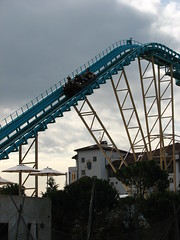 As for the ride itself… what’s there to say, it’s a flume on rails so it gets its own RCDb entry. It was interesting to note that the turntables which would reverse the boat for the middle drop before the main plunge into the reservoir would add extra rotations to kill time depending on if the block ahead of it was still occupied. On my boat we did I think a full 450° on the first turntable, but then only a single 90° on the second. I later witnessed another boat only do two 90° turns because it had more clearance ahead of it. Odd. The backward drop added a nice variety of thrills as the first time to actually feel the boat coasting freely it was impossible to see where we were going. The final drop is also an improvement for basic Shoot-the-Chutes rides, with a ‘false’ splashdown keeping the speed up for a bit longer as we glide over a small bunny hill before the real soaking commences. At first I thought I had gotten dumped on, but as I got off and observed the actual damaged discovered it had been a triflingly small quantity, dry after several minutes.
As for the ride itself… what’s there to say, it’s a flume on rails so it gets its own RCDb entry. It was interesting to note that the turntables which would reverse the boat for the middle drop before the main plunge into the reservoir would add extra rotations to kill time depending on if the block ahead of it was still occupied. On my boat we did I think a full 450° on the first turntable, but then only a single 90° on the second. I later witnessed another boat only do two 90° turns because it had more clearance ahead of it. Odd. The backward drop added a nice variety of thrills as the first time to actually feel the boat coasting freely it was impossible to see where we were going. The final drop is also an improvement for basic Shoot-the-Chutes rides, with a ‘false’ splashdown keeping the speed up for a bit longer as we glide over a small bunny hill before the real soaking commences. At first I thought I had gotten dumped on, but as I got off and observed the actual damaged discovered it had been a triflingly small quantity, dry after several minutes.
While other thematic areas in the park could, despite all the wonderful attention to detail, feel a little overstuffed and crowded at times,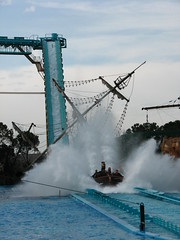 the large reservoir created for Atlantica was commendable for creating at least a fleeting impression of that incalculable immensity when looking out at the horizon of the ocean, a singular centerpiece giving the area more cohesion. I should note this observation was made while I was dining at the water’s edge with one of the only meals I’d eat inside the park,
the large reservoir created for Atlantica was commendable for creating at least a fleeting impression of that incalculable immensity when looking out at the horizon of the ocean, a singular centerpiece giving the area more cohesion. I should note this observation was made while I was dining at the water’s edge with one of the only meals I’d eat inside the park,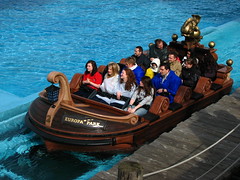 a Mediterranean chicken sandwich at a newly opened food stand in Portugal, which was one of the better ‘serious’ attempts at the culinary arts I’ve encountered in a large theme park (within a reasonable budget). This was while simultaneously attempting to shut out regrets that I’d most likely never take a chance to travel to Lisbon or see Portugal during my time in Europe.
a Mediterranean chicken sandwich at a newly opened food stand in Portugal, which was one of the better ‘serious’ attempts at the culinary arts I’ve encountered in a large theme park (within a reasonable budget). This was while simultaneously attempting to shut out regrets that I’d most likely never take a chance to travel to Lisbon or see Portugal during my time in Europe.
Although walking from a frigid, rocky Icelandic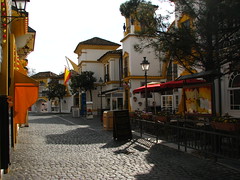 coastal town to suddenly be confronted with the Mediterranean serenity of Portugal might be too large of a tonal shift for even the most ardent admirers of theme park aesthetics, not as unnatural was the shift from Portugal to Spain. A mere two flat rides call this section home, but it is also one of the more elaborate and colorful sections in the whole park, a shame it had no major attraction to anchor the crowds. After making my way around a bend in the pathway, I once again had to make a slightly jarring cross-cultural jump as I suddenly entered Austria in the far back eastern corner of the park.
coastal town to suddenly be confronted with the Mediterranean serenity of Portugal might be too large of a tonal shift for even the most ardent admirers of theme park aesthetics, not as unnatural was the shift from Portugal to Spain. A mere two flat rides call this section home, but it is also one of the more elaborate and colorful sections in the whole park, a shame it had no major attraction to anchor the crowds. After making my way around a bend in the pathway, I once again had to make a slightly jarring cross-cultural jump as I suddenly entered Austria in the far back eastern corner of the park.
The primary attraction of interest here was Alpenexpress, the parks first (and for me, last) roller coaster, one of Mack’s essential powered coasters. Like the other rides at Europa Park,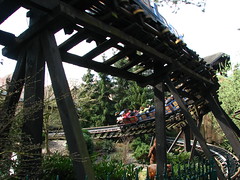 this was a well-designed attraction with a significant section of the layout taking place inside an elaborate diamond cavern shared with the log flume. This ride more or less functions as the park’s children’s coaster, although it’s an amusing enough of a scenic jaunt that all patrons are encouraged to give it a try.
this was a well-designed attraction with a significant section of the layout taking place inside an elaborate diamond cavern shared with the log flume. This ride more or less functions as the park’s children’s coaster, although it’s an amusing enough of a scenic jaunt that all patrons are encouraged to give it a try.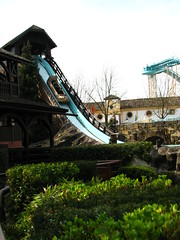
Next door was the Tirol Log Flume, again, well executed in terms of thematic attention but a tad forgettable after the larger flumes at Holiday Park and Tripsdrill, the main interest with this was the shared cavern section with Alpenexpress. As I was getting off I noticed the Vienna Wave Swinger was just letting on board peeps for a cycle, so I quickly joined. Generally a pleasant ride, if only because it lets me get off my feet for a few minutes. I wonder if the fountains underneath are turned up on warmer days
As I was getting off I noticed the Vienna Wave Swinger was just letting on board peeps for a cycle, so I quickly joined. Generally a pleasant ride, if only because it lets me get off my feet for a few minutes. I wonder if the fountains underneath are turned up on warmer days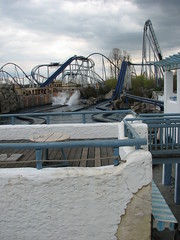 to clean unsuspecting rider’s sneakers?
to clean unsuspecting rider’s sneakers?
At this point I made my way around the back eastern edge of the park which are mostly gardens and parklands with a few low key flat rides (assuredly chosen because they generate the least noise) before rejoining the main entry area upon which I indulged in mini-marathons of Silver Star and Eurosat as well as once on each of the attractions covered in the Day 1 report. Just past Switzerland was Greece, the country my flatmates had chosen on visiting for spring break instead and I would have to settle for the theme park version to enjoy the sights of ancient Athens.
to enjoy the sights of ancient Athens.
First up in Greece is Pegasus. This family coaster (coined a YoungSTAR coaster by Mack, and they actually label it on park maps as such) features a twisted layout that includes an approximately 90° banked turn after the first drop. Kids love it. There’s nothing intense at all about it. I saw more hands in the air on that element than on the regular s-curves later on in the layout. You hear that, coaster designers, 90° banking are not ‘extreme’ any more, if they ever were! The forces all equal out and you remain planted firmly in your seat as if you were just going around any other curve. Now, underbank these turns, and then you might have something more interesting going on. For Pegasus I don’t think that’s what desired, however. It’s a ride that’s meant to feel like one of the larger, more important coasters while still being accessible to all. In that way it’s a tad redundant with so many other family coasters in the park (there’s nothing in particular about it that makes it intended for a younger audience apart from the manufacturer’s name for it) but it gets kids on the ride and helps them overcome their fears of the big rides when they realize that steep drops and sharp turns are no big deal in the world of modern, precision force-designed steel roller coasters. I think a lot of people that go on the small family coasters which jerk them around and feel a bit unsafe are scared of the larger rides because they assume those traits will be multiplied by a factor of ten, when in reality the opposite is the case.
for a younger audience apart from the manufacturer’s name for it) but it gets kids on the ride and helps them overcome their fears of the big rides when they realize that steep drops and sharp turns are no big deal in the world of modern, precision force-designed steel roller coasters. I think a lot of people that go on the small family coasters which jerk them around and feel a bit unsafe are scared of the larger rides because they assume those traits will be multiplied by a factor of ten, when in reality the opposite is the case.
One such ride that may scare people off of riding the larger coasters for that reason is the Poseidon water coaster whose cobalt blue track wraps around the Pegasus. Let’s just say I was less than enamored with the coaster sections due to some very poor tracking of the water coaster boats on the rails, exacerbated by some hard, rigidly formed seating which rendered many of the high-speed sections a couple notches beyond ‘uncomfortable’. If this were in service of an intense layout I might not mind as much, but as it was the coaster track sections seemed to be there just to prove they could mix them with a water ride, not adding particularly much besides some sweeping turns before a splashdown. I was also surprised at the complete lack of any dark ride sections, I figured that would be a given with this sort of ride (perhaps I was substituting Orlando’s Journey to Atlantis with this one in my mind). Despite these reservations the presentation was top-notch, both from off-ride, in the queue, and on many of the low-speed sections of the flume. It’s a nice, long ride with two lifts (and subsequently,
very poor tracking of the water coaster boats on the rails, exacerbated by some hard, rigidly formed seating which rendered many of the high-speed sections a couple notches beyond ‘uncomfortable’. If this were in service of an intense layout I might not mind as much, but as it was the coaster track sections seemed to be there just to prove they could mix them with a water ride, not adding particularly much besides some sweeping turns before a splashdown. I was also surprised at the complete lack of any dark ride sections, I figured that would be a given with this sort of ride (perhaps I was substituting Orlando’s Journey to Atlantis with this one in my mind). Despite these reservations the presentation was top-notch, both from off-ride, in the queue, and on many of the low-speed sections of the flume. It’s a nice, long ride with two lifts (and subsequently,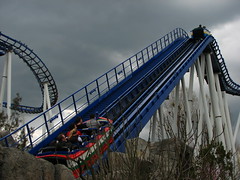 two splashdowns, neither of which were particularly wet) and if judged as a water ride then it’s absolutely
two splashdowns, neither of which were particularly wet) and if judged as a water ride then it’s absolutely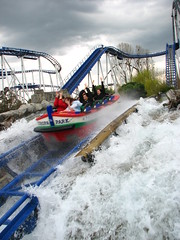 near the top of its league. However, if you ride it hoping for some good roller coaster or dark ride elements, you’ll almost certainly get off sharing some of the mild disappointment I did.
near the top of its league. However, if you ride it hoping for some good roller coaster or dark ride elements, you’ll almost certainly get off sharing some of the mild disappointment I did.
Other rides sampled in Greece included Fluch der Kassandra (Cassandra’s Curse), a rotating madhouse attraction which managed zero affect on me. Do these even qualify as rides or are they shows? Understanding what the irate Greek goddess was cursing at us might have helped (not that it can be as much fun to fill in the blanks with one’s imagination). Also nearby was Abenteuer Atlantis, a shoot-em-up dark ride which seemed directed toward a younger audience, but regardless offered some good target practice.
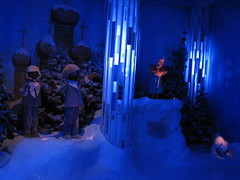 Moving into Russia (which seems to be stretching the ‘European nations’ theme a little bit, at least as nowhere else in Eastern Europe or even Ireland or Belgium has representation yet; besides, the last time Germans tried moving into Russia it didn’t work out too well for them) I first encountered the Schlittenfahrt Schneefloeckchen (The Snowflake Ride). This seemed to be a vaguely Small-World-esque dark ride taking me past various wintery Christmas scenes in a way that wasn’t particularly memorable to me but seemed like something the kids would fall in love with especially on days when the park needs the added capacity. I was surprised by how many dark rides seemed nonchalantly scattered throughout Europa Park, I had already missed a couple in Italy and still had another major one after this.
Moving into Russia (which seems to be stretching the ‘European nations’ theme a little bit, at least as nowhere else in Eastern Europe or even Ireland or Belgium has representation yet; besides, the last time Germans tried moving into Russia it didn’t work out too well for them) I first encountered the Schlittenfahrt Schneefloeckchen (The Snowflake Ride). This seemed to be a vaguely Small-World-esque dark ride taking me past various wintery Christmas scenes in a way that wasn’t particularly memorable to me but seemed like something the kids would fall in love with especially on days when the park needs the added capacity. I was surprised by how many dark rides seemed nonchalantly scattered throughout Europa Park, I had already missed a couple in Italy and still had another major one after this.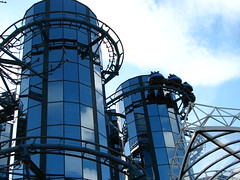
But first, a roller coaster: Euro-Mir. At first brush this caught me as being slightly redundant with another space-themed, indoor spiral lift non-looping steel coaster whose name begins with the word “Euro” already in the park (and being a thoroughly great ride, I will add), but I guess this one has the spinning and the mod-skyscraper building look as well, and it seemed to be the most raved about ride in the park before Silver Star and Blue Fire came along, so a fair chance definitely seemed worth it. Finding no wait whatsoever, it really makes no difference if you choose to face forward or backward because the cars will start spinning on the spiral lift anyway. A loud spacey-techno beat drives as the train slowly makes its way around one layer of upward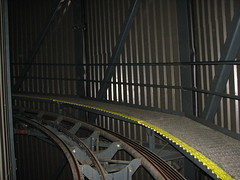 helix after another (the train is propelled by a large rotating central drum which catches a beam attached to the rear car), some neat effects such as an opening in the drum revealing a scene of Russian Cosmonauts distracts from the fact that it seems to be taking a while to get to the top. Anticipation starts to build as a distant light at the top of the tower eventually shines brighter and closer, at which point we exit the building and are greeted with: more waiting.
helix after another (the train is propelled by a large rotating central drum which catches a beam attached to the rear car), some neat effects such as an opening in the drum revealing a scene of Russian Cosmonauts distracts from the fact that it seems to be taking a while to get to the top. Anticipation starts to build as a distant light at the top of the tower eventually shines brighter and closer, at which point we exit the building and are greeted with: more waiting.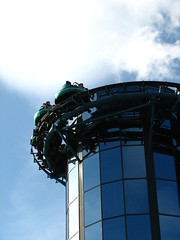
Well, now it’s a series of switchbacks between the towers at sky level as the cars seem to freely spin. It’s not based on the weight distribution as on most spinning coasters but there seems to be some mechanism which causes the act of turning itself to propel them to spin; generally inertia keeps the trains facing a single direction on spinning coasters and it’s the slight friction combined with a weight distribution which sets them off in one direction or another. At this point we’re still having fun but I think if I check my watch I’ll discover that it’s been a good three to four minutes of ride time before anything has actually happened yet. I might call this a case of increasing tension and building anticipation in another context, but it’s not entirely clear what it is we should be anticipating, and slowness comes off as a delayed start. The turns aren’t sharp enough to produce any wild-mouse laterals on their own, we’re mostly just taking in the view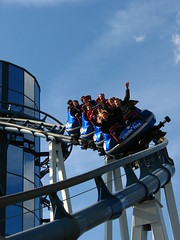 on a gentle spin cycle. On the last set of switchbacks the spinning locks and we prepare for the big drop.
on a gentle spin cycle. On the last set of switchbacks the spinning locks and we prepare for the big drop.
Like its Sitting predecessor, this one is for no lack of intensity, the opening spiral drop hitting very hard (especially for those facing backward) and encouraging all but the bravest cosmonauts on board to hang on. There’s a bit of play between the track and wheels which can make the sudden onslaught of high speed feel dangerous, but otherwise there shouldn’t be any discomfort. As we make our way back up a hill the cars all twist around 180 degrees before locking once more and the ride that follows is an interesting collection of helices and figure-eights much in the same vein as Eurosat but without the dark setting. If you’re unfortunate enough to have been caught going backwards for this the ride might even prove to be a bit too intense, so relentless are the curves with and transitions which force some rather unexpected g-spikes due to some imperfections in the force engineering or heartlining. A tight inclined helix beneath a waterfall before slamming into a brake run tunnel all-too soon eventually finishes the experience.
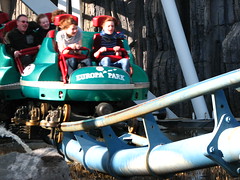 Definitely one of the wildest spinning coasters I’ve ever been on (at least once it gets going after the interminable opening acts), I sort of wished they gave the ride more than two settings (wait mode and insane mode) and that so much of the track and
Definitely one of the wildest spinning coasters I’ve ever been on (at least once it gets going after the interminable opening acts), I sort of wished they gave the ride more than two settings (wait mode and insane mode) and that so much of the track and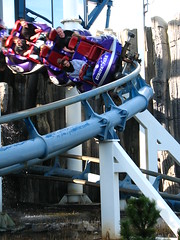 ride time wasn’t devoted to the former rather than the latter. In the end I still had to throw my preferences to the non-spinning Eurosat, as that one offered a more concise package that also rewarded more on rerides (the dark setting making it impossible to memorize the layout offered a bit more than an outdoor spinning coaster when the spinning was in no way unpredictable), but in terms of purely minimalist or avant-garde forms of roller coaster expression (a disappointingly rare field of entry), Euro-Mir may ultimately prove itself to be the Kraftwerk or Can of the German roller coaster scene.
ride time wasn’t devoted to the former rather than the latter. In the end I still had to throw my preferences to the non-spinning Eurosat, as that one offered a more concise package that also rewarded more on rerides (the dark setting making it impossible to memorize the layout offered a bit more than an outdoor spinning coaster when the spinning was in no way unpredictable), but in terms of purely minimalist or avant-garde forms of roller coaster expression (a disappointingly rare field of entry), Euro-Mir may ultimately prove itself to be the Kraftwerk or Can of the German roller coaster scene.
The skies were beginning to open up to some light rain so I took shelter in the entrance to Piraten in Batavia in the park’s Dutch section. Apparently the setup with this one is Dutch pirates sail to the Far East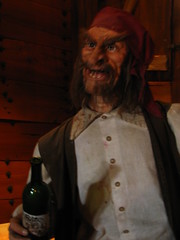 and while there various hi-jinks ensue with the locals, such as chasing wenchs on a turntable gags, cats on a floating barrel gags, dogs holding keys in its mouth gags, and… wait a minute, I’ve seen all of this before! Indeed, between Universe of Energy, Geisterschloss, the Snowflake Ride and this (as well as who knows how much else at the park I may have missed) it seems a very disappointing and classless move for a park such as Europa Park to casually ‘borrow’ so many ideas from the Disney catalogue of rides. Cheap Asian parks or small carnival/FECs I can understand why they might be tempted by risking a copyright infringement lawsuit, because the people that run those places want a cheap way to get back their investment so why not copy the most successful theme park chain on earth? Europa Park’s copy-catism is more troubling, and not only because these ideas ‘justly’ belong to Disney.
and while there various hi-jinks ensue with the locals, such as chasing wenchs on a turntable gags, cats on a floating barrel gags, dogs holding keys in its mouth gags, and… wait a minute, I’ve seen all of this before! Indeed, between Universe of Energy, Geisterschloss, the Snowflake Ride and this (as well as who knows how much else at the park I may have missed) it seems a very disappointing and classless move for a park such as Europa Park to casually ‘borrow’ so many ideas from the Disney catalogue of rides. Cheap Asian parks or small carnival/FECs I can understand why they might be tempted by risking a copyright infringement lawsuit, because the people that run those places want a cheap way to get back their investment so why not copy the most successful theme park chain on earth? Europa Park’s copy-catism is more troubling, and not only because these ideas ‘justly’ belong to Disney.
High-end dark rides are a rather rare phenomenon. Sets, ride systems, show buildings, animatronics, attention to detail, these things do not come free. As humans we are very blessed that one thing that does come cheaply are ideas. Now, to have a truly good idea, that might take some hard work,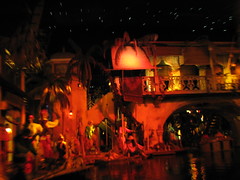 but thankfully it is work that involves few (if any) monetary constraints. And that’s where the beauty of the creative arts comes from, the ideas behind it. Technical ability is essential to the communications process, but ultimate if the idea isn’t there, no one’s going to care. The good news with dark rides is you don’t need a particularly elaborate idea to start off from, as generally you are telling relatively simple narratives or trying to craft a singular atmospheric presence that the idea can come pretty cheaply. I myself often stay up late nights thinking up elaborate schemes of just how far I can push an idea for a dark ride to the furthest extremes of the medium. I’m sure I’m not the only fan without the means or resources that’s had an idea but no way to carry it out.
but thankfully it is work that involves few (if any) monetary constraints. And that’s where the beauty of the creative arts comes from, the ideas behind it. Technical ability is essential to the communications process, but ultimate if the idea isn’t there, no one’s going to care. The good news with dark rides is you don’t need a particularly elaborate idea to start off from, as generally you are telling relatively simple narratives or trying to craft a singular atmospheric presence that the idea can come pretty cheaply. I myself often stay up late nights thinking up elaborate schemes of just how far I can push an idea for a dark ride to the furthest extremes of the medium. I’m sure I’m not the only fan without the means or resources that’s had an idea but no way to carry it out.
Therefore how insulted do I feel sitting inside a multimillion euro show building going past elaborate detailed sets, observing the creative fruits of a design team that was blessed with those rare circumstances of having the means to make that dream happen, while I am keenly aware that the only thoughts that ever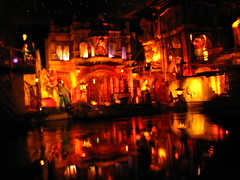 once enter this ride’s creative process were how they can make it just different enough to not get slapped with a copyright infringement lawsuit from Disney. It’s not like the copying of Pirates of the Caribbean was done to save money since they still must design and build the system from the ground up, it just shows that whoever was responsible for devising this showed zero respect for any creative considerations and was only focused on making sure that their investment could turn a profit by copying an already successful idea. I find there to be some subtle but still perceptible contempt for humanity in this sort of thinking, especially when equally successful original ideas are out there waiting
once enter this ride’s creative process were how they can make it just different enough to not get slapped with a copyright infringement lawsuit from Disney. It’s not like the copying of Pirates of the Caribbean was done to save money since they still must design and build the system from the ground up, it just shows that whoever was responsible for devising this showed zero respect for any creative considerations and was only focused on making sure that their investment could turn a profit by copying an already successful idea. I find there to be some subtle but still perceptible contempt for humanity in this sort of thinking, especially when equally successful original ideas are out there waiting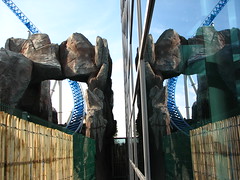 to be realized but never given the chance.
to be realized but never given the chance.
Then again, who am I kidding, even the very idea of ‘ideas’ has been so reified in today’s media culture that the phrase “having an idea” is synonymous with “acquiring intellectual property”. The few high-end dark rides built today which aren’t a cross-promotional tool for the park’s parent company’s IPs are attempted knock-offs of those same ride systems, although thankfully the Sally corporation has been responsible for a few gems at independent parks willing to play the role of the original Disney rather than simply copy his successes (i.e. Nights in White Satin or Labyrinth of the Minotaur, the former unfortunately defunct after one season).
 After sampling the Fjord Rafting in Scandinavia (this bordered more closely on ‘dangerously wet’ but I somehow managed to avoid most of the big spills) I decided the best way to spend the remaining two hours of my time at Europa Park was to simply marathon through the queue of Blue Fire. The wait started out at some five minutes long, eventually dropping down to waiting one or two train cycles, and then becoming walk-on, in part thanks to all three trains being on the track and cycled with the same efficiency as if it were peak season. (If the originality of the dark rides is something to bemoan to Europa Park management about, then this worth giving them a high-five) I managed to nab some 20 or so rides in that two-hour window, bringing my total of laps between the two days at Europa Park to over thirty. The moral of the story is apparently: visit on weekdays in early season!
After sampling the Fjord Rafting in Scandinavia (this bordered more closely on ‘dangerously wet’ but I somehow managed to avoid most of the big spills) I decided the best way to spend the remaining two hours of my time at Europa Park was to simply marathon through the queue of Blue Fire. The wait started out at some five minutes long, eventually dropping down to waiting one or two train cycles, and then becoming walk-on, in part thanks to all three trains being on the track and cycled with the same efficiency as if it were peak season. (If the originality of the dark rides is something to bemoan to Europa Park management about, then this worth giving them a high-five) I managed to nab some 20 or so rides in that two-hour window, bringing my total of laps between the two days at Europa Park to over thirty. The moral of the story is apparently: visit on weekdays in early season!
For some reason, whenever I first entered the queue I would be gobsmacked by the overpowering smell of fresh shrimp. Seriously. I don’t know if this was an attempt at crafting thematic ambiance taken a step too far or it might have simply been from all the freshly cut wood installed by the fences and as flooring for the new Gazprom Hall building, but the smell has yet to leave my mind whenever I think about Blue Fire. Anyway, the queue has apparently been rerouted for 2010 to now start at the far end of the Iceland midway (near the end of the coaster’s launch track) to take guests through an interactive hall sponsored by a European energy company showcasing the technological marvels man has created to scale the sheer power of nature’s furies in order to harness new forms of energies so you can power your hairdryer. After a hike through the middle of the coaster’s layout the queue splits into two for front row riders and the rest of the train. Unfortunately this makes getting a front row ride nearly impossible as nearly half the people choose that queue not realizing just past the stairs is an additional hour long wait.
and as flooring for the new Gazprom Hall building, but the smell has yet to leave my mind whenever I think about Blue Fire. Anyway, the queue has apparently been rerouted for 2010 to now start at the far end of the Iceland midway (near the end of the coaster’s launch track) to take guests through an interactive hall sponsored by a European energy company showcasing the technological marvels man has created to scale the sheer power of nature’s furies in order to harness new forms of energies so you can power your hairdryer. After a hike through the middle of the coaster’s layout the queue splits into two for front row riders and the rest of the train. Unfortunately this makes getting a front row ride nearly impossible as nearly half the people choose that queue not realizing just past the stairs is an additional hour long wait.  An attendant assigns seats keeping the rest of the train loading quickly, although specific seat requests are a bit harder to come by.
An attendant assigns seats keeping the rest of the train loading quickly, although specific seat requests are a bit harder to come by.
The overall ride concept is highly imitative of Intamin’s Accelerator coasters, down to the five-car trains, although Mack tried to find ways to improve on Intamin’s designs wherever they could, most notable is the new restraint system. An over-the-head lapbar does away with any shoulder restraints or straps leaving one’s upper body completely free save for some awkward ribcage guards along the seatback which were apparently added forgetting that people have these things we call arms. I also have to question whether the overhead lapbar accommodates as many physical sizes as a standard floor mounted lapbar, but with a 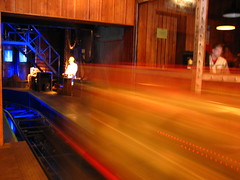 B&M-like raised seating lifting rider’s feet off the floor I’ll still declare it a far superior system to any mounted by Intamin (and this ride features more inversions than any Accelerator has attempted as well). Getting a chance to try Maverick’s twisted horseshoe roll or missing barrel roll without upper body restriction was possibly the most anticipated single coaster feature of my entire spring break.
B&M-like raised seating lifting rider’s feet off the floor I’ll still declare it a far superior system to any mounted by Intamin (and this ride features more inversions than any Accelerator has attempted as well). Getting a chance to try Maverick’s twisted horseshoe roll or missing barrel roll without upper body restriction was possibly the most anticipated single coaster feature of my entire spring break.
But first we have to make our way through the darkride portion of the coaster, which unfortunately doesn’t add much to the ride as it could. The train is briskly moved through two 90 degree turns into the launch area without much time to savor the surroundings, not that there’s much to savor anyway as it’s mostly faceless ‘scientific’ props in a cave set a couple meters away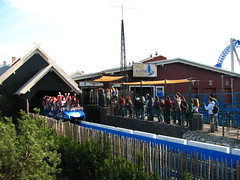 from the track to accommodate safety catwalks, all while the usual theme park danger alarms attempt to dramatize the proceedings. A thick cloud of vaporized fog juice appears just ahead of the front car, which we are then promptly launched through by the LSMs, apparently to disorient those closer to the front as they try to cough the thick substance out of their lungs down the launch track.
from the track to accommodate safety catwalks, all while the usual theme park danger alarms attempt to dramatize the proceedings. A thick cloud of vaporized fog juice appears just ahead of the front car, which we are then promptly launched through by the LSMs, apparently to disorient those closer to the front as they try to cough the thick substance out of their lungs down the launch track.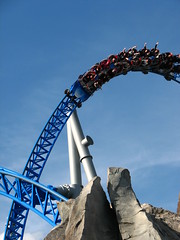
I forget what it was like when the concept of launching coasters was still new to me but it takes not much short of Top Thrill Dragster scaled launchs to thrill me these days so the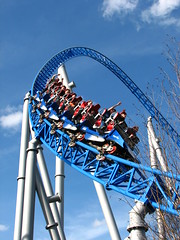 launch generally ends up being the least memorable part of the ride. Blasting through a small tunnel the train rears up and to the left for the ride’s signature original maneuver, the banked camelback/tophat crest thing (hmm, not sure if an official name has ever been coined for this element). It’s an odd element to say the least, offering a form of airtime that’s sort of there but not really. Now I understand that in theory a 90 degree bank over a parabolic crest should create perfect weightlessness (once you achieve zero-g’s it doesn’t matter what you’re orientation to earth is, a fact I wish more coaster designers would take advantage of) but I was slightly skeptical it would actually work as intended. The further seats front or back of the train where negative-g whip is more likely to be achieved would here translate into laterals, and that assumes a perfectly accurate launch speed able to generate zero-g’s for the center car. As it turned out, there was
launch generally ends up being the least memorable part of the ride. Blasting through a small tunnel the train rears up and to the left for the ride’s signature original maneuver, the banked camelback/tophat crest thing (hmm, not sure if an official name has ever been coined for this element). It’s an odd element to say the least, offering a form of airtime that’s sort of there but not really. Now I understand that in theory a 90 degree bank over a parabolic crest should create perfect weightlessness (once you achieve zero-g’s it doesn’t matter what you’re orientation to earth is, a fact I wish more coaster designers would take advantage of) but I was slightly skeptical it would actually work as intended. The further seats front or back of the train where negative-g whip is more likely to be achieved would here translate into laterals, and that assumes a perfectly accurate launch speed able to generate zero-g’s for the center car. As it turned out, there was 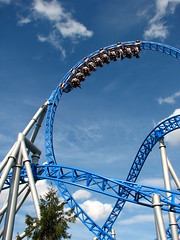 much less distortion of forces than I anticipated and I was more or less held perfectly in my seat no matter where I sat save for the very front or back rows. While it’s nowhere near as dynamic an opener as Intamin’s top hat designs, the visuals offered to riders are no less bizarre and it seems a fitting opener to a ride that’s gentle and unsure of its pace but packed with quirky maneuver nevertheless.
much less distortion of forces than I anticipated and I was more or less held perfectly in my seat no matter where I sat save for the very front or back rows. While it’s nowhere near as dynamic an opener as Intamin’s top hat designs, the visuals offered to riders are no less bizarre and it seems a fitting opener to a ride that’s gentle and unsure of its pace but packed with quirky maneuver nevertheless.
Sliding down into another cave tunnel the train shoots into a large, 32 meter tall vertical loop. Like the first hill this is really a very dynamically simple element but it doesn’t matter (yet) because it’s large and smooth enough to still impress, especially if you know how to take advantage of the free upper body movement while cresting the top near zero-g’s. Following this is a very quickly rotating overbanked skirt to the right, disharmonious to the gentle pacing that preceded it but a pleasure for fans of Stengel’s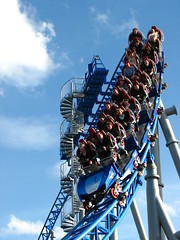 tight trackwork on advanced Intamin layouts.
tight trackwork on advanced Intamin layouts.
The train rises up into a midcourse brake run hill, the front car getting a huge blast of airtime, the rest of the train getting nothing. As a side commentary, while magnetic braking offers many advantages, one of the biggest disadvantages to this technology is that it is binary and static. That is, it only has two modes (on/off) and even then it’s hard to switch between them without lowering the entire rigging in a way that makes split-second response times hard to activate unless they’re kept on at all times. This is a problem with Blue Fire’s midcourse brake (and perhaps why these aren’t seen on many other coasters relying on magnetic braking) because a fixed set of magnets ensure the train is always slowed down enough in case a singular pinch caliper at the end of the track needs to halt the train, which only occurs in the rare cases of e-stops. Better safe (and high capacity) than sorry, though this does kill some of the ride’s potential a bit too early into the layout.
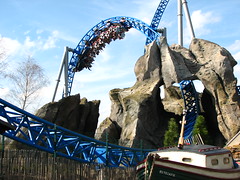 Nevertheless the coaster quickly recovers with one of the better elements, the twisted horseshoe roll, offering more gentle, floating airtime around the tops of the two barrel-rolling inversions while incorporating it with rotational twists around the heartline. Rockwork daring us to scrape our extended fingers against does not detract from this elements quality, either.
Nevertheless the coaster quickly recovers with one of the better elements, the twisted horseshoe roll, offering more gentle, floating airtime around the tops of the two barrel-rolling inversions while incorporating it with rotational twists around the heartline. Rockwork daring us to scrape our extended fingers against does not detract from this elements quality, either.
It took me a while before I realized just how important floater air was to understanding this layout, perhaps due to an absence of straight airtime hills. The only one that is featured along the layout comes next, which appeared to pace slightly too slow from offride, yet it somehow always managed to provide a noticeable upward push whenever I was onboard the train.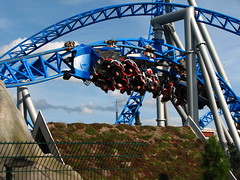 A carouseling lefthand turnaround follows before it’s into the ride’s final maneuver, an inline twist. I don’t think it’s perfectly inline; looking down the barrel of this element reveals what might be a heartline path which follows a slight bump so the train doesn’t rotate in a 1-g environment (I believe this to partly be the cause of failing on Maverick’s heartline roll). Sitting on the right side of the train was mandatory to best enjoy this element as the rotation pulls the seat right out from under you and around a full 360°, offering a potent g-force cocktail of ejector negative-g’s, rotational g’s and lateral g’s, such that whenever this element came around, even if I’d be experiencing the whole coaster up to that point in a tranquil, Zen-like state, I’d always be sure to throw my arms out as far as I could to get maximum displacement of my center of gravity.
A carouseling lefthand turnaround follows before it’s into the ride’s final maneuver, an inline twist. I don’t think it’s perfectly inline; looking down the barrel of this element reveals what might be a heartline path which follows a slight bump so the train doesn’t rotate in a 1-g environment (I believe this to partly be the cause of failing on Maverick’s heartline roll). Sitting on the right side of the train was mandatory to best enjoy this element as the rotation pulls the seat right out from under you and around a full 360°, offering a potent g-force cocktail of ejector negative-g’s, rotational g’s and lateral g’s, such that whenever this element came around, even if I’d be experiencing the whole coaster up to that point in a tranquil, Zen-like state, I’d always be sure to throw my arms out as far as I could to get maximum displacement of my center of gravity. 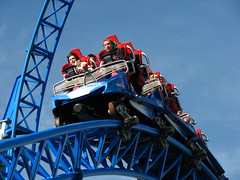 (Unfortunately since I was often the single rider, the other person would be the one to enter first taking the right side seat). A final turn and we slide into the brakes, I check the heart rate monitor on the handgrips to make certain I hadn’t died (often it reported I had).
(Unfortunately since I was often the single rider, the other person would be the one to enter first taking the right side seat). A final turn and we slide into the brakes, I check the heart rate monitor on the handgrips to make certain I hadn’t died (often it reported I had).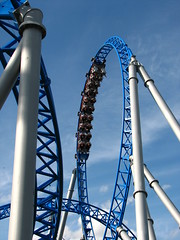
Without question Blue Fire is one of my top three steel coasters in continental Europe. In its first year of operation it made a run for the top ten best steel coasters worldwide according to the Mitch Hawker coaster poll, and from the handful of other visitor who have had a chance to sample it I have read nothing but rave reviews. I think it’s clear that Mack has developed a ride system which set a new standard of quality to be envied by every other steel coaster developer currently working. The first park to buy the next Mack LSM coaster will surely be watched with tremendous interest.
However, by my estimations Blue Fire itself falls short of achieving the greatness some of its competitors have been able to achieve. My principle problem with the design is that the pacing and sequencing between elements is incredibly weak and directionless. Except for the second half of the horseshoe roll, no one element is in any way predicated or necessitated by the one prior or subsequent to itself. Part of this might be owing to the coaster’s gentler disposition with a greater emphasis on airy weightlessness than the raw force-fests of some of Intamin’s better launched looping coasters (Maverick, Storm Runner, iSpeed), which is a perfectly acceptable, even commendable alternative. But even still, a better effort at sequencing the elements, with particular attention paid to the transition moments as the train moves between the signature inversions, I am positive would have yielded significantly improved results.
My principle problem with the design is that the pacing and sequencing between elements is incredibly weak and directionless. Except for the second half of the horseshoe roll, no one element is in any way predicated or necessitated by the one prior or subsequent to itself. Part of this might be owing to the coaster’s gentler disposition with a greater emphasis on airy weightlessness than the raw force-fests of some of Intamin’s better launched looping coasters (Maverick, Storm Runner, iSpeed), which is a perfectly acceptable, even commendable alternative. But even still, a better effort at sequencing the elements, with particular attention paid to the transition moments as the train moves between the signature inversions, I am positive would have yielded significantly improved results.
One of the best ways to test whether a coaster is well-sequenced is to apply a pattern analysis to the layout and see if any discernible repetitions or progressions can be found. However in the case of Blue Fire it’s nearly impossible to even define what counts as a particular color or symbol when charting the layout’s pattern because nearly none of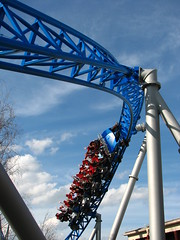 the elements described above share any qualities with the others, every maneuver or sensation remains undefined within the context of the entire ride. The weightlessness present in many elements was the only thing I indicated that is a consistent theme throughout the coaster experience, but the same is true of any B&M speed coaster and I’d certainly never declare one of those rides a champion of good pacing or progression so long as zero-g’s are arbitrarily applied throughout the layout and without discrimination.
the elements described above share any qualities with the others, every maneuver or sensation remains undefined within the context of the entire ride. The weightlessness present in many elements was the only thing I indicated that is a consistent theme throughout the coaster experience, but the same is true of any B&M speed coaster and I’d certainly never declare one of those rides a champion of good pacing or progression so long as zero-g’s are arbitrarily applied throughout the layout and without discrimination.
It doesn’t help that I think the design was constrained by the requirements of filling a perfectly rectangular building area, necessitating that elements be sequenced in accordance to their ability to best fill that area than for any reasons of flow or progression. The high-speed turn after the loop surprises and excites because it seems violently unfitting in the context of the first two elements, but this is immediately followed up by a midcourse brake run whose placement on top of a hill only serves to make it a dead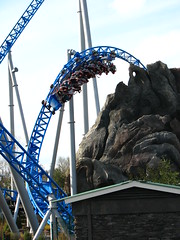 element for everyone not in the lead car.
element for everyone not in the lead car.
Even the twisted horseshoe roll, despite the spectacular setting curling dangerously close to the rock structures, is weakly applied to the layout compared to the one seen on Maverick. On Maverick the roll is bookended by two flat curves which mirror the turn in the middle, each of these recalling the first ground-level flat turns. There now is a pattern. The element is ‘forceful’ not because of increased g-forces, but because each roll now stands as a stronger alternative to the established pattern of switchbacks experienced just moments ago. Each moment fits within the context of the rest of the ride. On Blue Fire however, they designed it so the horseshoe roll is bookended by slightly veering hills. Without the context, all we are left with when we start to rise back up into the first inversion is nothing more than a singular element, like the vertical loop that preceded it. The second roll is therefore an unnecessary (but still welcomed) surprise, another stand-alone element that happens to be similar to the one before it. This lack of necessity to each moment – we’re doing it just because the designers can – ultimately produces a “who cares?” attitude towards the layout as a whole, as summed up by the final heartline roll which totally blindsides us coming in the middle of a series of weak, meandering hills and turns. Thankfully it stands in as an ad-hoc climax to an ending that would have otherwise been completely forgettable.
– ultimately produces a “who cares?” attitude towards the layout as a whole, as summed up by the final heartline roll which totally blindsides us coming in the middle of a series of weak, meandering hills and turns. Thankfully it stands in as an ad-hoc climax to an ending that would have otherwise been completely forgettable.
In the end I find myself riding and enjoying Blue Fire just because each moment does happen to be quite giddy fun, and in a world where throwing 15 million euro at a coaster project doesn’t even guarantee you won’t get a lemon, that’s all that should really be asked for. The variety is certainly there as well and there’s no question that the experience is a consistent one (another fun element tends to crop up every several seconds or so)… it just consistently isn’t very well planned out. To reiterate my earlier statement: without question Blue Fire is one of my top three steel coasters in continental Europe. Whether that says more about the quality of Blue Fire’s ‘fun-ness’ or about the relative quality of every other steel coaster on the continent (that I managed to ride at least) I will leave the reader to decide.
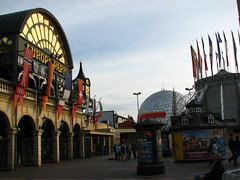 Fully satiated with enough Blue Fire rides to last me until I may make a return to Europa Park, it was time to make my way to the park exit. While walking I had a nice conversation with the attendant on duty assigning seats who needless to say was able to recognize me and was curious to know how many time I rode it in one day. “You’re very fortunate”, he told me, “there are days in the summer when people will wait three hours for one ride.”
Fully satiated with enough Blue Fire rides to last me until I may make a return to Europa Park, it was time to make my way to the park exit. While walking I had a nice conversation with the attendant on duty assigning seats who needless to say was able to recognize me and was curious to know how many time I rode it in one day. “You’re very fortunate”, he told me, “there are days in the summer when people will wait three hours for one ride.”
This stroll was a bittersweet one, as I had now seen everything I wanted to see for my eleven days of travel between four countries, and needed to resume classes. However, while I might have been done with this trip, this trip was far from done with me.
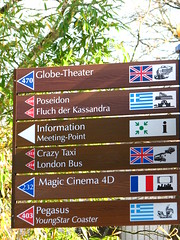
Comments